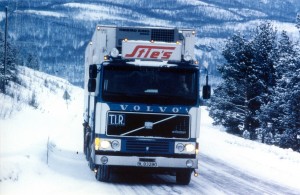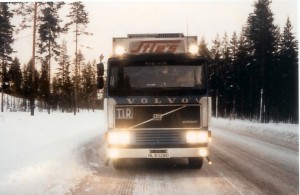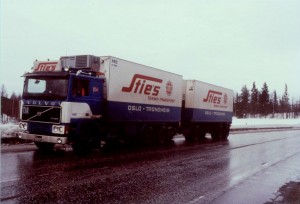Ride to North Norway with Sties.
10 September 2017 by Gerrit de Heus
Posted in History of Sties
 Sties is a fairly big international company specialised in refrigerated transport. It is therefore possible to encounter the blue/white trucks throughout Europe: Spain, Italy, Russia and the Netherlands, you name it and Sties will be driving there. For a country such as Norway refrigerated transport is of great importance. During the winter months the production of fresh foods is almost nothing! Products such as lettuce, cucumbers, tomatoes, etc. will have to be imported during that time. One of the exported products in Norway is fish and for that they also need refrigerated transport.
Sties is a fairly big international company specialised in refrigerated transport. It is therefore possible to encounter the blue/white trucks throughout Europe: Spain, Italy, Russia and the Netherlands, you name it and Sties will be driving there. For a country such as Norway refrigerated transport is of great importance. During the winter months the production of fresh foods is almost nothing! Products such as lettuce, cucumbers, tomatoes, etc. will have to be imported during that time. One of the exported products in Norway is fish and for that they also need refrigerated transport.
Sties has around sixty truck on the road, mostly Volvo and Scania. Obviously every truck has its own driver. The trucks that drive on the “inland” are renewed every two to three years. At that point they have driven around 300.000 kilometres and, for the conditions they endured, this is more than enough. STIES wants its drivers to have appropriate materials at their disposal.
Helge Hansen is working for Sties Thermo-transport for five years. The last two, three years he’s been driving on the inland. Before that time, you could encounter him everywhere in Europe. How comparatively the inland is, becomes clear as soon as I got on his truck. Helge: “We will go to the north of Norway through Sweden and Finland, in order to reach Alta. It’s impossible to drive another route, as my truck is too tall for the crossovers in Norway. The crossovers are 3.80 meters tall, while the truck is between 3.90 and 4 meters tall.”
The distance seems not so bad if I listen to Helge say it’s 450 Norwegian miles, but it turns out that Norwegian miles are totally different from the English ones: a Norwegian mile is apparently 10 kilometre. Throughout the year, Helge makes this trip around 45 times.

The roads resembled ski slopes.
Even though I had just taken place in the Volvo F1225 Intercooler, I was already startled: the roads resembled ski slopes! They are incredibly small, around two and a half meters, and covered in a layer of ice. Helge is intensively changing gears and from time to time a wheelset is either raised or dropped to get more grip on the road. A Dutch truck would already be alongside the road.
“It lies in the spikes.” Tires with metal spikes make sure that the truck stays on the road. Or at least that was the intention, but even though the truck had tires with spikes, it sometimes happened that the wheels lost their grip. When that happened, Helge quickly undertook action.
With a speed of around twenty kilometres per hour we moved through the night. Helge: “We are accustomed to it. From September to May there is snow on the roads and then they look like this. Of course there are some differences between trips and some might be worse than others, because you simply can’t control the weather or the reindeers. But, because we always drive in these circumstances, we gained a lot of experience. Last year for example, there was a Spaniard that had a delivery in Bergen. For us, that is a trip that normally takes around ten hours of driving. It turned out he needed three days to get there. A lot more dangerous are the reindeers. Those animals suddenly jump out of the forest and if you weren’t paying attention, you will most certainly hit them.”
Suddenly there’s a moose is on the road..
From the forest a moose appears. Because of all the light on the trucks, we can easily follow the movements of the animal. The spotlights on the truck are in situations like these a lifesaver, because it makes it possible to see the animal on time and brake before anything happens. Over the radio a colleague is warned of the moose, as he’s driving just behind us.
Just now the radio catches my attention. De Norwegian drives don’t use it very often: only when they encounter a colleague and have to warn them for slippery conditions or other dangers.
Another phenomenon in the Norwegian truck is the car-phone. With this, the drivers have a direct connection with a radio station at which they can call in traffic jams, heavy weather, and so on. Besides this, the phone is used to call the firm, families and for instance the customs at the border.
The latter is indeed called this time,
because we won’t make it to the Swedish border before closing time. After calling the customs, they agreed to stay open a little longer just for us. At the border at Østby we enter Sweden. The road doesn’t get any wider at this point. The only thing recognizable is a sign with “Customs” on it and a crossing gate; no waiting times and no exaggerated formalities
Helge: “That’s one of the reasons why I chose to drive on the inland: no hassles at the borders. In Northern Europe it’s not that big of a problem, but when you get to France or Italy it’s just a mess. I was sick and tired of those circumstances and then I didn’t even get started on the South-German police, because those people are incredibly corrupt.”
Only the tracks in the snow show a sign of life..
We’re driving for about six hours now and the truck has become somewhat of a snow castle. The rear lights and the name of the firm are almost no longer visible. Furthermore all the snow that is falling from the air obstructs our view. It’s a lonely night. Only the tracks in the snow show that there are other living beings wandering around. At about half past two at night we stop in Sveg, where we will be taking a short nap.

Very short, because three hours later we are already back on the road again. Snowploughs are already busy with keeping the roads accessible and removing the snow that has fallen over night. Keeping the roads clean is a huge task and they use all kinds of material to achieve this: bulldozers, snowploughs and trucks. It’s weird to see all those trucks full of snow.
Helge and I had renamed the current road towards Sveg to motorway, as it was a full two and a half meters wide! When we passed the city, the road became even wider. We have around 4 meters of road at our disposal at this point, but it keeps being covered in a layer of ice and we still have to be on the lookout. Over a distance of 100 kilometres the temperature drops from -9 degrees to -24 degrees. Later on, in Finland, it would become even colder: there the temperature dropped from +2 degrees to -35 degrees. This cold is not something you would notice, as there is not much wind. The only thing you will notice is your nose internally freezing and when you get to a warm place again you find out you have a nosebleed.
The trip through Sweden would occupy the rest of the day. Even though it’s slippery on the road, they drive pretty fast; after all you don’t know what the situation is like hereafter.
At the first stop in Sweden, the first problems also arise. These problems were not for us, but for one of Helge’s colleagues. They’re having trouble with the air supply of the trailer. Some bolts are loosened, others are tightened and within half an hour the problem was resolved.
More to the North the landscape becomes rugged and barren
As we move further northward, the landscape changes: trees become smaller and overall it becomes barren. When driving here, an intense feeling of loneliness overwhelms you: hours go by without seeing any oncoming traffic, villages or cities. A weird feeling when you are accustomed to the overcrowding in the Netherlands. Also the length of day changes and indicates that we move further north. Around 9 or 10 o’clock the sun rises and by 4 o’clock twilight falls.
One barrier indicates where the border is..
On a small abandoned mountain road a border crossing suddenly emerges; we’re driving out of Sweden again. The last couple of hours we were busy driving up the mountains, which divides both of the countries, without us even noticing. After the border crossing, the descent begins and with it the pain in our ears (due to the differences in altitude). Even though it’s dark, the spotlights make it possible for me to look at the sides of the road. What I see is an abyss of a couple of hundred metres deep, just behind a paper-thin crash barrier.
Meanwhile, Helge is calmly calling his wife while steering through hairpin turns without any trouble. At the foot of the mountain, the abyss is exchanged for an icy river. We drive on trough the tunnels from fjord to fjord. Twice that night we cross a fjord as the only passengers on a ferry.
A pallet of pizza’s
It’s Thursday morning 8 o’clock, we’ve been driving from Tuesday afternoon around 4 o’clock and in total we’ve only had 5 hours of sleep and three times a day a break of half an hour. The first unloading point is Narvik, where a pallet of pizza’s had to be delivered. It is slippery; we can’t drive faster than 25 km/h – low gear, rear wheels up and that’s how we crawl up the mountain.
Tromsø
A collision! Suddenly, from a side street in downtown Tromsø, a car appeared. It was too late to brake. Because we had already unloaded a couple of times this morning at different places, the truck had became a lot lighter and therefore it slipped. Helge immediately grabs a camera from his bag to capture the damages. The Volvo appears not to have much damage, but the car is pretty busted. Later, when we call Stie’s to tell them about the accident, it shows that it was useful to capture the damages: the owner of the car had already called the firm. His estimate of the damages was around six-thousand Crowns (which is roughly two and half thousand guilders). According to Helge’s estimation that would be enough to buy two instances of that car.
Helge: “We capture the damages for the insurance cases. Encounters with difficult people, like this one, occur more often than you would expect. By taking those pictures, we have evidence in case they destroy their car even more themselves. I believe the damages this time were around 450 Crowns, which is something entirely different than the amount the person indicated.” At Stie’s they already thought the damages were a bit exaggerated and luckily they could laugh about it. “I will put on the snow chains now, as one collisions is enough.
 The northern lights are amazing to see..
The northern lights are amazing to see..
Tromsø is behind is and in front of us lays Alta, the place where we will pick up our new cargo for the ride back. This time we will ride through Finland to one of the most northern villages in Norway. This time there will be no overpasses, but the roads seem to be in such a bad condition that it’s better to take a detour. On the Finnish steppe the temperature drops to -35 degrees Celsius. It is so cold that, even though the heating is on, the windows freeze on the inside.
Slowly it starts to become dark, suddenly… the northern lights. A fantastic experience: a kind of green-yellowish glow in the sky. We get spooked as we suddenly see blinking lights: another one of Stie’s trucks. We stop for a while to talk, exchange experiences and ask how the road is up ahead. The contact we just had was the last for a long time being.
We’re driving again. The road is like a long ribbon swirling in front of us, again that feeling of loneliness. Then suddenly: two wolves at the side of the road. Because of the headlights we luckily see them on time. If we happen to get stranded here.. I don’t want to think about it. Not only the predators are dangerous around here: three Swedish oncoming trucks almost push us off the road. It takes a lot from Helge to keep the truck nicely on the road.
 At the North Cape we load fish for Italy
At the North Cape we load fish for Italy
In Alta, around two hundred kilometers from the North Cape, we load fish to be taken to Italy. In Oslo the fish shall be loaded into another truck.
The next day it’s Sunday and that means that the stores will be closed in Sweden. Therefore we decide to do our shopping today. At around 12 o’ clock we leave Alta and start our ride to Oslo.
You would expect it to be extremely cold up here in the North, but this is not the case: it rains!
Because of this the roads become somewhat impassable and slippery. West-Finmark, the area that we have to go through later, is the opposite of this: there a blizzard is storming.
In the first couple of hours of the ride, nothing much happens. Shortly after, however, the visibility gets worse and worse up to the point that we can’t see anything but white: fog. Luckily it doesn’t take too long for the fog to disappear; only an hour or two. We’re driving on the same type of small roads as we were at the beginning of our journey. Occasionally oncoming traffic spooks us and before you know it, a side mirror gets hit. This is a good indication of how small the roads really are: two trucks can barely pass each other on it. Helge responds indifferent to the incident; it appears it happens often.
Difficulties with the technology
 Once we’ve left Finland, everything seems to improve: the roads are better than they were in Sweden and for the first time in days they are clean. At a burger joint we run into Finn. Finn works for Alta transport and is also transporting fish to Oslo.
Once we’ve left Finland, everything seems to improve: the roads are better than they were in Sweden and for the first time in days they are clean. At a burger joint we run into Finn. Finn works for Alta transport and is also transporting fish to Oslo.
He has some problems with the cooling engines. We decide to wait for the mechanic together so we can ride together afterwards. In the meantime we decided to get some sleep.
Once we’re back on the road, the problems start: the brakes of Finn’s trailer aren’t working. Helge and Finn try, together, to fix it and it works. Around a hundred kilometers further it is our turn: the lights on the trailer stopped working. This means that there is no light on both the left and the right of the truck.
Helge: “Everything short circuits. The fuses I put in immediately burst, one by one. We can’t solve the problem here. The roads might be clean of snow, but that is because they use tons of salt and because of the salt you get problems like this. The only thing we can do now is ride on with the current lights we have.”
Later we also find out that the heating at my side had been broken down. With my legs covered in jackets I’m able to survive the cold. We enter Norway again at the border crossing in Østby. The customs officer seems to remember me: they don’t meet many Dutch people there.
customs controls on tachochraaf here that is incorporated into the wheel hub
The end of the trip is now in sight and we’re even quicker home than anticipated. Two hours ahead of the planning we drive into Oslo and stop the truck for a last cup of coffee.
“My truck is my home” it says on Helge’s shirt. When I shut the door of the Volvo for the last time and tell him goodbye, I feel that it has also become a part of my home.





Comments
We would appreciate it if you could leave a message.